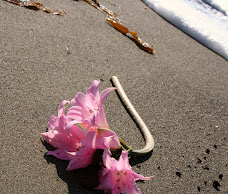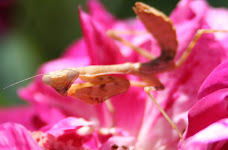
The colony of acorn woodpeckers that lives in the three oaks next to my house is worth telling about. Since we're next-door neighbors and the birds live their lives in the open, I've learned some of their habits by observation. What I've seen has driven me to bird books, for which I thank my grandfather and my mother, and possibly their grandfathers too, because I've read that reading is a learned behavior.
Both my mother, Frances, and Granddad Joe carried Audubon books into the forests and deserts we visited, and I remember the pair of them, sometimes with my aunt or uncles, poring over books at picnic tables, laboriously trying to identify--by studying the minute features of it--some particular tree or bird or flower.
They could spend what seemed like hours doing this. And the family still can't visit wildlife, or even our back yards sometimes, without hauling out the reference books and binoculars.
The acorn woodpecker excited some discussion among us all.
We're fortunate here in the oak woodlands to have these birds; their range is small, and from what my books tell me, they seem unique among woodpeckers. Both males and females wear a red cap and a black and white tuxedo, and they've been exceedingly busy this month with their acorn harvest.
One of my three oaks is what's called a granary tree: This one large oak is where they store their harvest, in holes peppered all up and down the length of the tree's trunk and arcing out into its branches.
The wonderful thing, the unique thing, about these woodpeckers is their community. They live as a colony in these three trees. Everyone harvests, everyone works hard poking acorns into well-worn holes, everyone helps.
They share in the work, and they share in the bounty. We wondered if they harvest grubs that might grow in the stored acorns, but the books say they live all year on the acorns themselves, stored so meticulously in the granary tree.
They even cooperate in raising their young, from sharing the duties of incubating the eggs to sharing the endless chore of feeding the young and, finally, training them to fly. The young belong to everyone.
I have seen this colony of woodpeckers work together also to fend off an onslaught of starlings that appeared one day earlier this year. The woodpeckers unified to protect their interest in the three oaks. Even though the numbers of starlings and woodpeckers seemed about even, after several hours of strategic swooping and chattering, the woodpeckers convinced the starlings to set up house elsewhere.
Together they protect their habitat. They take care of their "land" and resources, reusing the same holes year after year. They diversify by consuming crops from different varieties of oaks, and they maintain emergency supplies, living on nature's bounty of insects when that "crop" is available.
They share in the rearing of their offspring, cooperating in raising up a new brood of responsible woodpeckers and sending them off to find new communities elsewhere, thus keeping their population stable and not overtaxing their resources.
It appears to me that the acorn woodpeckers illustrate the life of a good community--my own, I hope.
I hope my community's leaders make decisions that use our resources well and protect our habitat.
I hope the spirit of cooperation flourishes in the statewide and national level, that we all work hard to be good stewards and share the bounty of our efforts with those less fortunate than we are.
God bless us, every one.
Both my mother, Frances, and Granddad Joe carried Audubon books into the forests and deserts we visited, and I remember the pair of them, sometimes with my aunt or uncles, poring over books at picnic tables, laboriously trying to identify--by studying the minute features of it--some particular tree or bird or flower.
They could spend what seemed like hours doing this. And the family still can't visit wildlife, or even our back yards sometimes, without hauling out the reference books and binoculars.
The acorn woodpecker excited some discussion among us all.
We're fortunate here in the oak woodlands to have these birds; their range is small, and from what my books tell me, they seem unique among woodpeckers. Both males and females wear a red cap and a black and white tuxedo, and they've been exceedingly busy this month with their acorn harvest.

One of my three oaks is what's called a granary tree: This one large oak is where they store their harvest, in holes peppered all up and down the length of the tree's trunk and arcing out into its branches.
The wonderful thing, the unique thing, about these woodpeckers is their community. They live as a colony in these three trees. Everyone harvests, everyone works hard poking acorns into well-worn holes, everyone helps.
They share in the work, and they share in the bounty. We wondered if they harvest grubs that might grow in the stored acorns, but the books say they live all year on the acorns themselves, stored so meticulously in the granary tree.
They even cooperate in raising their young, from sharing the duties of incubating the eggs to sharing the endless chore of feeding the young and, finally, training them to fly. The young belong to everyone.
I have seen this colony of woodpeckers work together also to fend off an onslaught of starlings that appeared one day earlier this year. The woodpeckers unified to protect their interest in the three oaks. Even though the numbers of starlings and woodpeckers seemed about even, after several hours of strategic swooping and chattering, the woodpeckers convinced the starlings to set up house elsewhere.
Together they protect their habitat. They take care of their "land" and resources, reusing the same holes year after year. They diversify by consuming crops from different varieties of oaks, and they maintain emergency supplies, living on nature's bounty of insects when that "crop" is available.
They share in the rearing of their offspring, cooperating in raising up a new brood of responsible woodpeckers and sending them off to find new communities elsewhere, thus keeping their population stable and not overtaxing their resources.
It appears to me that the acorn woodpeckers illustrate the life of a good community--my own, I hope.
I hope my community's leaders make decisions that use our resources well and protect our habitat.
I hope the spirit of cooperation flourishes in the statewide and national level, that we all work hard to be good stewards and share the bounty of our efforts with those less fortunate than we are.
God bless us, every one.
Chris A
Photograph by Greg Cope





9 comments:
Thanks for your nice visits to my blog darlin'.
I loved this post. I went back and read your post from Sept. 2, I would hate to watch my Mother go backwards in time like that. I already feel like an orphan, how about you?
I wish in many ways that we were more like the animals in our behavior. Thanks for posting this about the woodpeckers and how their sense of community is so different from ours.
Very cool.My husband and I take our guide books with us too. We're geeky that way.
We don't have those woodpeckers here and it was intersesting to learn a little about them.
My dad would sit at his kitchen window, facing the woods with his Audobon bird book, and a pair of binoculars, drink coffee,(or beer)and watch birds.
I inherited bird watching and, unfortunately, my alcoholism from him.
Great post.jeNN
I enjoyed reading about the habits of woodpeckers. Now, those are good lessons for all of us, indeed.
You have such a big heart! This was a lovely lesson on woodpeckers. I wish I knew more about birds and the stars too...hey, what's stopping me? Hope your day is filled with lots of community goodness!
Unified woodpeckers. I think I'm going to look at the birds in the woods out back with a new perspective.
enchanting! what a good community bird that is...
I have tried to make it as simple as the Woodpeckers have made it. Sadly man is not avian nor as easily classified with a book and good binoculars. Though people of good heart may yet have an effect.
Awesome post! Thank's for taking me back. We had woodpeckers galore where I grew up and I used to love watching them!
Post a Comment